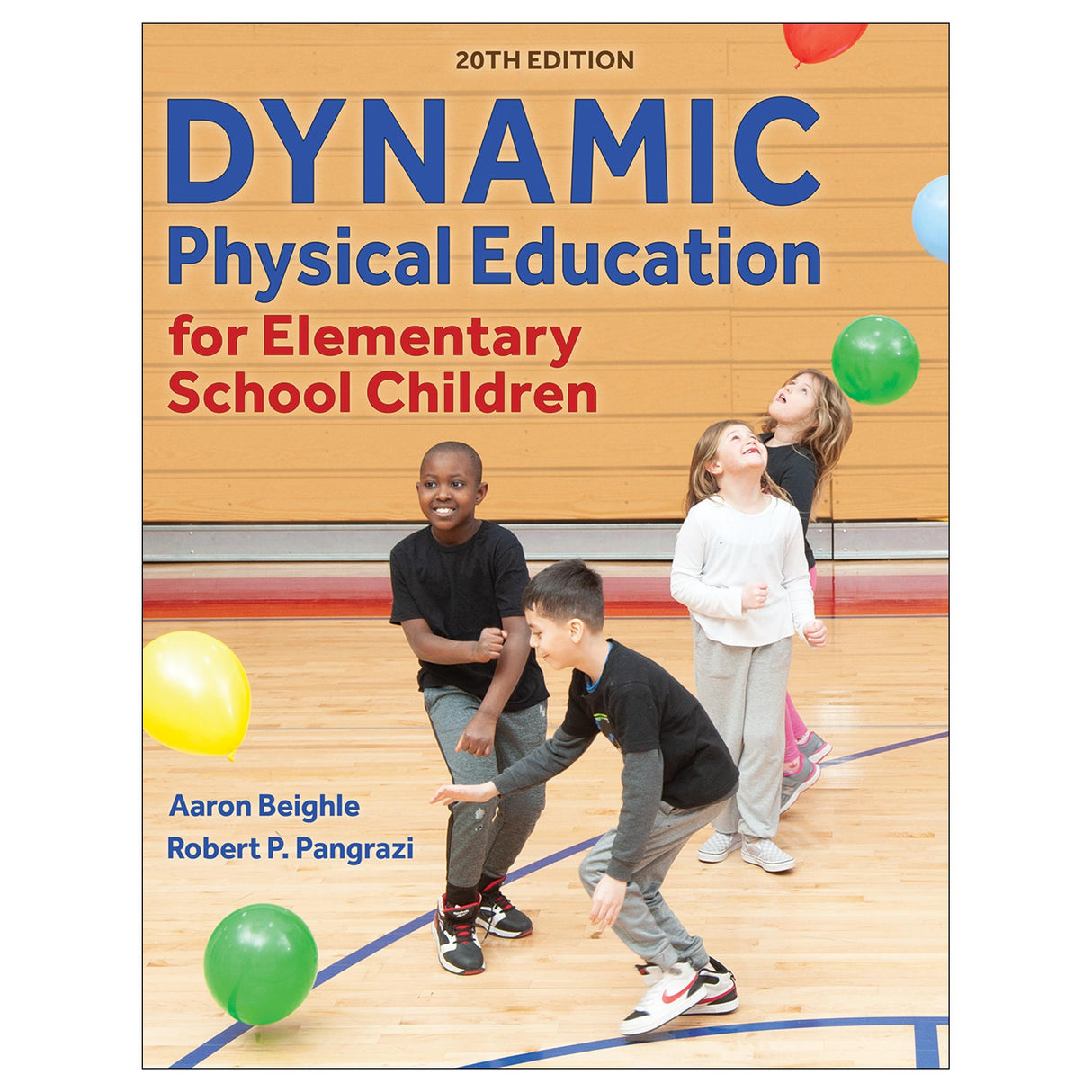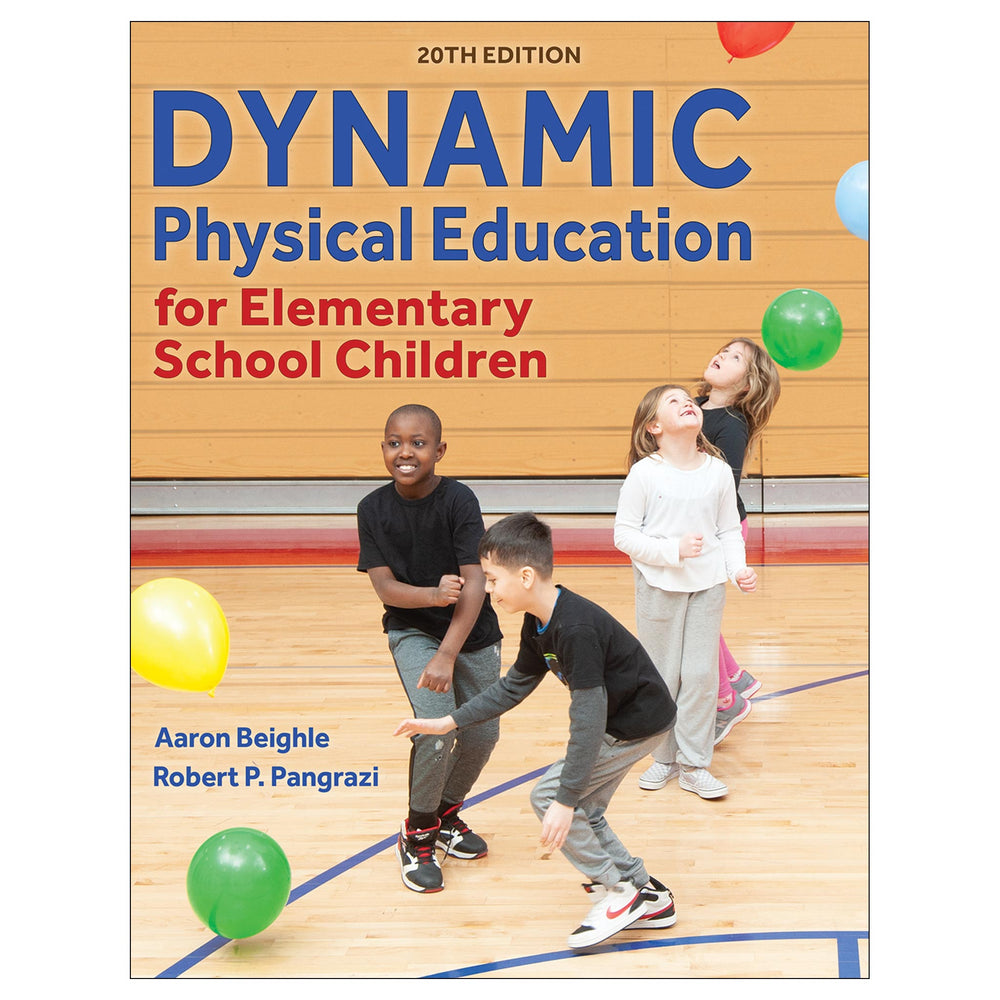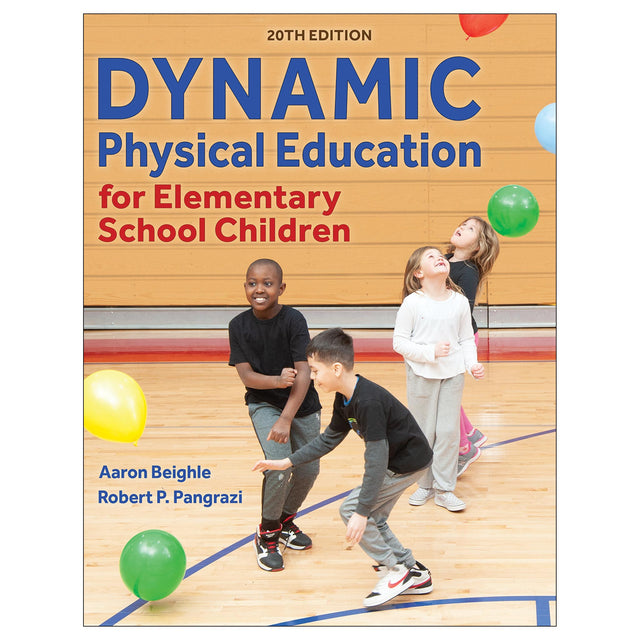Dynamic Physical Education for Elementary School Children-20th Edition
Author: Aaron Beighle, Robert P. Pangrazi
$152.00 USD
The text is supplemented by the free interactive website Dynamic PE ASAP, which includes a lesson-building tool with more than 500 activities, a customizable 36-week yearly plan, free downloadable instructional signs and assessments, and curriculum plans and activity videos. Together, the book and website put a complete plan for quality physical education at teachers’ fingertips.
The book also offers practical teaching tips, case studies of real-life situations to spark discussion, and instructor resources (an instructor guide, presentation package, and test package) that make preparing for and teaching a course a breeze.
The 20th edition has been updated to reflect the latest knowledge and best practices in physical education, including the following:
- Dynamic Physical Education standards as a framework for a physical education program
- Content on equity, diversity, inclusiveness, justice, culturally sensitive pedagogy, and trauma-informed teaching
- A new chapter on racket-related skills for tennis, pickleball, handball, and badminton
- Additional lifetime activities, including golf, discs, and climbing wall
With its emphasis on skill development and the promotion of lifelong healthy activity, Dynamic Physical Education for Elementary School Children is highly applicable for both physical educators and classroom teachers. It is an ideal text to support an elementary methods PE course, providing the detail that PETE students need. The content is also very accessible to students learning to become elementary education teachers.
With this latest edition, Dynamic Physical Education for Elementary School Children remains the go-to book for both preservice and in-service teachers—just as it has been for more than 50 years.
Audience
Text for PETE students in elementary physical education methods courses. Text for elementary education students. Reference for K-12 PE curriculum directors and elementary PE teachers.Chapter 1. Physical Activity and Health for Youth
Benefits of Physical Activity
Current Physical Activity Recommendations
Current Youth Physical Activity
Moderate to Vigorous Physical Activity (MVPA)
Physical Education and Physical Activity Promotion
Cornerstones of Our Profession
School-Based Physical Activity Promotion
CSPAP Leader
Learning Aids
Chapter 2. Growth and Development
Physical Growth and Development
Helping Children Find Success in Physical Activity
Safety Guidelines for Physical Activity
Learning Aids
Chapter 3. Elementary School Physical Education
What Is Physical Education?
What Essential Components Make a Quality Physical Education Program?
What Is the Current Status of Physical Education?
Do We Need Physical Education?
How Do Physical Educators Promote Physical Activity?
What Do We Teach in Physical Education?
Dynamic Physical Education Standards
How Has Physical Education Evolved?
Learning Aids
Part II. Instruction and Administration
Chapter 4. Effective Teaching and Instruction
Connecting With Students
Instructional Skills
Provide Instructional Feedback
Employ Effective Communication Skills
Reflect on Your Teaching
Evaluating Your Teaching
Learning Aids
Chapter 5. Building Effective Learning Environments
Effective Management and Discipline: A Coordinated Approach
Use Proper Teaching Behaviors
Define Class Procedures, Rules, and Consequences
Incorporate Efficient Management Skills
Teach Acceptable Student Behavior
Use Behavior Management to Increase Acceptable Behavior
Decrease Unacceptable Behavior
Use Criticism Sparingly
Learning Aids
Chapter 6. Lesson Planning
Steps to Lesson Planning
Other Considerations When Planning Lessons
Choose an Instructional Formation
Reflective Teaching
Learning Aids
Chapter 7. Curriculum Development
Designing a Quality Curriculum
Step 1: Develop a Guiding Philosophy
Step 2: Define a Conceptual Framework for the Curriculum
Step 3: Consider Environmental Factors
Step 4: Determine Content Standards
Step 5: Select Child-Centered Activities
Step 6: Organize Selected Activities Into Instructional Units
Step 7: Evaluate and Modify the Curriculum
Learning Aids
Chapter 8. Assessment
Types of Assessment
Methods of Assessment
Monitoring Physical Activity
Grading
Program Accountability
Evaluate Your Program
Learning Aids
Chapter 9. Including All Children
Least Restrictive Environment
Inclusion
Screening and Assessment
Understanding an Individualized Education Program (IEP)
Successful Inclusion
Recruiting Paraeducators and Volunteers
Learning Aids
Chapter 10. Legal Liability, Supervision, and Safety
Torts
Negligence and Liability
Types of Negligence
Common Defenses Against Negligence
Areas of Responsibility
Safety
Equipment and Facilities
Personal Protection: Minimizing the Effects of a Lawsuit
After-School Sports Programs
Learning Aids
Chapter 11. Facilities, Equipment, and Supplies
Indoor Facilities
Equipment and Supplies
Purchasing Policies
Indoor Equipment
Equipment and Supplies for Physical Education
Storage Plans
Care, Repair, and Marking
Constructing Equipment and Supplies
Outdoor Facilities
Safety on the Playground
Funding Equipment
Learning Aids
Part III. Foundational Skills
Chapter 12. Introductory Activities
Introductory Activities Using Locomotor Movements
Rhythmic Introductory Activities
Introductory Activities With Equipment
Partner and Small-Group Introductory Activities
Creative Introductory Activities
Tambourine-Directed Activities
Games and Miscellaneous Activities
Chapter 13. Physical Fitness
Definitions of Physical Fitness
Create Positive Attitudes Toward Fitness
Teaching About Physical Fitness
Avoid Harmful Practices and Exercises
Fitness Activity Progressions
Using Fitness Activities in Lessons
Fitness Activities for Developmental Level I
Fitness Activities for Developmental Levels II and III
Children and Fitness Testing
Approaches to Fitness Tests
Fitness-Testing Issues
Learning Aids
Chapter 14. Movement Concepts and Themes
Classification of Human Movement Concepts
Teaching Movement Skills and Concepts
Movement Skills and Concepts Lesson Plans
Teaching Movement Themes
Learning Aids
Chapter 15. Locomotor and Nonlocomotor Skills
Fundamental Skills
Locomotor Skills
Nonlocomotor Skills
Learning Aids
Chapter 16. Manipulative Skills
Manipulative Skills
Manipulative Skill Activities
Activities With Balloons and Beach Balls
Activities With Beanbags
Activities With Balls
Juggling
Activities With Scoops and Balls
Bowling Activities
Activities With Wands
Activities With Hoops
Activities With Jump Ropes
Pre–Rope-Jumping Skills
Long-Rope Jumping
Double Dutch (Two-Rope) Jumping
Individual Rope Jumping
Footbag Activities
Rhythmic Gymnastics
Learning Aids
Part IV. Specialized Skills
Chapter 17. Body Management Skills
Safe and Effective Use of Apparatus
Activities With Climbing Ropes
Activities on Balance Beams
Activities on Benches
Activities With Jumping Boxes
Activities With Individual Mats
Activities With Magic Ropes (Jump Bands)
Activities With Partner Tug-of-War Ropes
Chapter 18. Rhythmic Movement Skills
Implementing the Rhythmic Movement Program
Creative Rhythms
Folk Dances
Progression of Folk Dances
Developmental Level I Dances
Developmental Level II Dances
Developmental Level III Dances
Introductory Square Dance
Culminating Events for the Rhythms Unit
Learning Aids
Chapter 19. Gymnastics-Related Skills
Progression and Developmental Level Placement
Instructional Methodology for Gymnastics
Safety Considerations
Instructional Procedures
Developmental Level I Activities
Developmental Level II Activities
Developmental Level III Activities
Learning Aids
Chapter 20. Cooperative Skills
Role of Cooperative Activities
Teaching Cooperative Activities
Group Challenges
Activities With Parachutes
Learning Aids
Chapter 21. Game Skills
Evaluating Games
Creating or Modifying Games
Cooperation and Competition
Safety
Teaching Games Effectively
Selection of Games
Sport Lead-Up Games
Developmental Level I
Developmental Level II
Developmental Level III
Miscellaneous Playground Games
Relays
Learning Aids
Part V. Lifetime Activities and Sports Skills
Chapter 22. Lifetime Activities
Walking
Orienteering
Hiking
Golf
Discs
Bowling
Climbing Wall
Learning Aids
Chapter 23. Basketball
Instructional Emphasis and Sequence
Basketball Skills
Instructional Procedures
Basic Basketball Rules
Basketball Drills
Basketball Activities
Basketball Skill Tests
Learning Aids
Chapter 24. Football
Instructional Emphasis and Sequence
Football Skills
Instructional Procedures
Football Drills
Football Activities
Football Skill Tests
Flag Football Formations
Learning Aids
Chapter 25. Hockey
Hockey Skills
Instructional Procedures
Hockey Drills
Hockey Activities
Hockey Skill Tests
Learning Aids
Chapter 26. Racket-Related Skills
Handball
Pickleball
Tennis
Badminton
Learning Aids
Chapter 27. Soccer
Modifications of Soccer for Children
Instructional Emphasis and Sequence
Soccer Skills
Soccer Drills
Basic Soccer Rules for Lead-Up Games
Soccer Activities
Soccer Skill Tests
Learning Aids
Chapter 28. Softball
Instructional Emphasis and Sequence
Softball Skills
Organizing for Instruction
Basic Softball Rules
Softball Drills
Softball Activities
Softball Skill Tests
Learning Aids
Chapter 29. Track, Field, and Cross Country Running
Instructional Emphasis and Sequence
Track and Field Skills
Running
Instructional Procedures
Organizing for Instruction
Track and Field Drills and Activities
Suggested Track Facility
Conducting Track and Field Days
Cross Country Running
Cross Country Meets
Learning Aids
Chapter 30. Volleyball
Instructional Emphasis and Sequence
Volleyball Skills
Instructional Procedures
Organizing for Instruction
Basic Volleyball Rules
Volleyball Activities
Volleyball Skill Tests
Learning Aids
Nine Animal Movements
Organize a Lesson Plan





Sample video showing master teachers demonstrating management strategies, fitness routines, and skill instruction
All ancillaries are free to adopting instructors through HKPropel.
Instructor guide. Includes takeaways, learning objectives, review questions from the book and suggested answers, lab activities, class projects, relevant websites, and suggested readings for each chapter.
Test package. Contains 580 questions in true-false, essay, and multiple-choice formats. The files may be downloaded for integration with a learning management system or printed for use as paper-based tests. Instructors may also create their own customized quizzes or tests from the test bank questions.
Chapter quizzes. Contains ready-made quizzes (10 questions each) to assess student comprehension of the most important concepts in each chapter.
Presentation package. Features more than 750 PowerPoint slides of text, artwork, and tables from the book that can be used for class discussion and presentation. New to this edition, the presentation package also includes links to videos showing master teachers in PE classes demonstrating book content. The slides in the presentation package can be used directly within PowerPoint or printed to make handouts for students. Instructors can easily add, modify, and rearrange the order of the slides.





